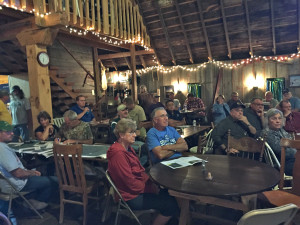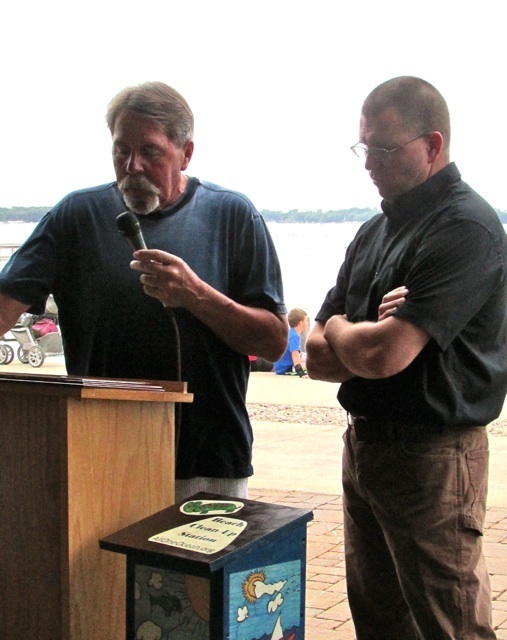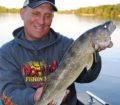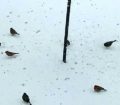By Steve Weisman

(photo by Steve Weisman) A good crowd was on hand at the Little Swan Lake open house to learn more about the upcoming Little Swan Lake restoration project.
Iowa is dotted with shallow water lakes, but in many cases, they are in incredibly poor shape. Over the years, for a variety of reasons, they have become impaired bodies of water with poor water clarity, lack of aquatic plant life, an over abundance of rough fish (carp), sporadic fisheries, limited wildlife use and production and as a result very poor recreational opportunities.
Iowa’s Shallow Lake Restoration program (lakes shallower than 10 feet) is designed to bring life back to these shallow water lakes. In northwest Iowa, lakes such as Diamond Lake, Dan Green Slough, Trumbull Lake and Marble and Hottes have either been renovated or are in the process of completion. Once renovated, the lake once again becomes a vibrant “alive” body of water. The water becomes incredibly clear, aquatic vegetation returns, rough fish are gone and game fish are re-introduced. This usually occurs over a 2-3 year time span.
Little Swan Lake
For the past several years, Little Swan Lake, which is located north of Superior, has become a pretty much forgotten about body of water. At last Tuesday’s community meeting held at Little Swan Lake Winery, over 40 interested people attended an open house to learn more about plans to renovate Little Swan Lake.
As with so many other similar shallow water lakes, Little Swan Lake’s water quality and habitat is greatly degraded. A recent electrofishing survey showed a huge population of carp and bullhead (93 percent) with only a few yellow perch and catfish. I can remember when I moved to Estherville in 1978, a lot of local anglers would go to Little Swan Lake to catch perch and northern pike. However, little to no fishing takes place now.
At the same time, back in the late 1970s, Little Swan Lake and the slough to the north were great waterfowl areas. That, too, has changed. Mike Hawkins, DNR Fisheries Biologist, and Chris LaRue, Wildlife Biologist, shared the Little Swan Lake Watershed Improvement plan with the crowd.
Currently, everything is in the planning stage with the hopes that work could begin in the summer or fall of 2016.
Success of the plan revolves around the following partners and funding sources:
- Iowa DNR, Fisheries and Wildlife Bureaus, Lake Restoration Program and the Watershed Improvement Section;
- Ducks Unlimited;
- North American Wetlands Conservation Act;
- Dickinson County Water Quality Commission;
- Spirit Lake Protective Association;
- Iowa Department of Agriculture, Land Stewardship;
- Natural Resources Conservation Service;
- Local landowners
The plan
First off, the dam on the northeast side of the lake is failing, and the lake has lost 12-14 inches of water because of this failure. So, a new dam will be constructed. To do this, obviously, water levels must be lowered. Drawing down the lake will induce a fishery renovation (killing all of the carp in the system). This is very crucial, because the common carp, which is an exotic/invasive fish introduced into the Midwest waters in the 1880s, is extremely prolific and greatly impacts shallow lakes and wetlands. Unfortunately, their feeding habits disturb sediment, cause water turbidity and destroy the very aquatic vegetation that help improve water clarity.
Plus, in addition to eliminating the carp, the drawdown will allow aquatic plant life to become established and also harden the bottom along the outer portions of the lake.
In-lake management now and in the future
By providing a proper in-lake management system, the DNR will be able to control the movement of water in and out of Little Swan Lake. Infrastructure placed near the lake outlet will allow managers to control both water and common carp movement with the goal of keeping the unwanted rough fish out of the lake. A second fish barrier will be installed downstream of Christopherson Slough (north) to stop common carp from reinfesting the entire watershed.
At the same time, if a drawdown is deemed necessary in the future, this structure will be there for that option. In that way, the DNR will be able to better control fisheries populations and promote natural and diverse aquatic plant life that will help ensure much better water quality.
The drawdown will probably last 1-2 years, depending on how quickly aquatic plants become well established. It also depends on what Mother Nature dishes out in large rainfalls, etc. Since Little Swan Lake has a watershed of nearly 11,000 acres, refilling the lake should go rather quickly.
Native fishes including yellow perch and northern pike will be stocked.
The bottom line
It’s taken decades for Little Swan Lake to get to this point. Unfortunately, it will not fix itself. It needs management intervention to improve water quality and bring the lake back to the shallow water jewel it once was.
I think that Scott Benjamin, owner of Little Swan Lake Winery located on the south side of Little Swan Lake, said it best. “If we don’t do this, what do we have? We will still have a lake that nobody ever comes to. This plan will help restore Little Swan Lake to what it once was!”
Cutlines: (photo by Steve Weisman)
#1b-
















